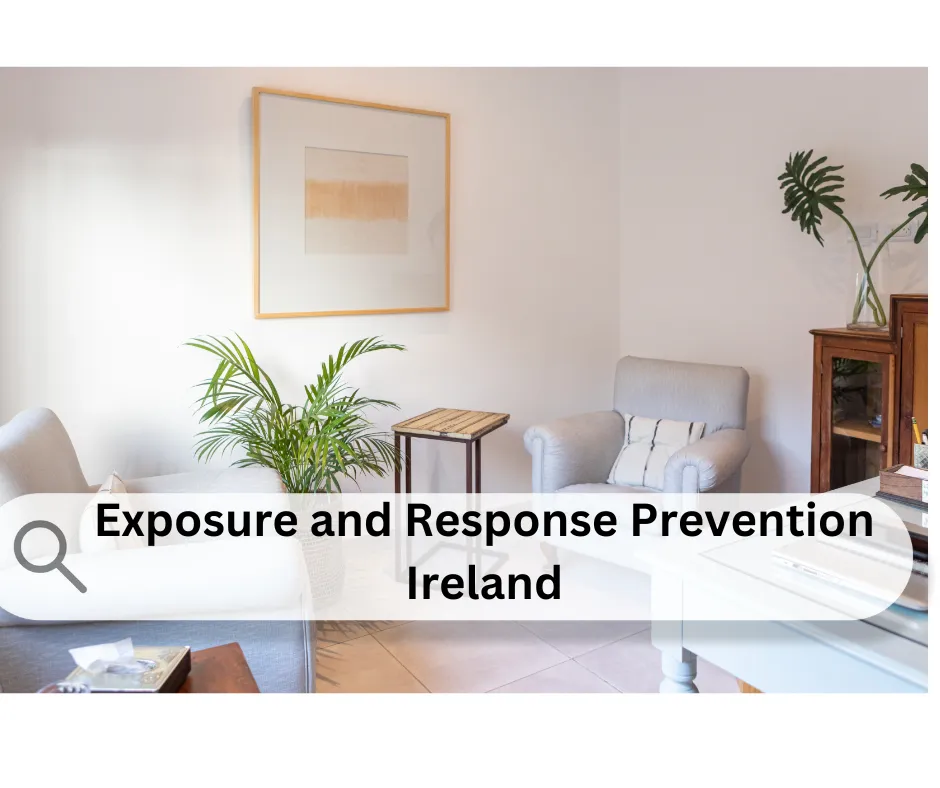Exposure and Response Prevention (ERP) therapy is a practical, step-by-step approach to treating not just OCD, but other anxiety disorders . Most people who contact me regarding ERP is because they have heard that it works for OCD (Learn more about how OCD works and how ERP can help.) – which it does – but I want to explain how incredibly using ERP is for treating anxiety disorders as well. Over my 20 years as a psychologist, I’ve come to deeply value Exposure and Response Prevention (ERP) as it provides a clear and practical way to make sense of what’s happening. I love working with this model because it breaks down overwhelming challenges into manageable steps, where people can actually see that their struggles aren’t random but follow very specific patterns that together we can address.

To illustrate, one of my clients, Aoife, initially felt consumed by her fear of contamination. Through ERP, we started with small exposures—touching a clean surface without immediately washing her hands. Over time, she progressed to touching objects she once avoided entirely, like doorknobs and shopping trolleys, all while resisting the urge to ritualize. But the satisfaction for me, lay with the fact, that she could see exactly what was causing her problem and knew exactly what she had to fix it, she finally had a way out. This quick example with my client Aoife shows how ERP therapy for OCD can help with contamination OCD, one of the common subtypes of OCD, but it can be successfully applied to all sub-types. I’ll talk next about how it works, because at it’s most simple; it works due to two things – expose yourself to the thoughts or images that you have being trying to avoid, and don’t do the compulsion! If you master that, you will feel a lot better, but of course, there is more to it than that and I’ll go through it with you now, including what would happen in session. If you want to start now, try these ERP exercises you can do at home.
ERP has basically two steps to master;
- exposure, and
- response prevention – hence the name of the model Exposure and Response Prevention.
Exposure: This involves intentionally facing the situations, thoughts, or sensations that trigger your anxiety in a safe and controlled way. Instead of avoiding these triggers, you gradually confront them. For example, if social anxiety makes you fear speaking in front of others, exposure might begin with saying a few words in a small, supportive group before progressing to larger audiences.
Response Prevention: This step helps you resist engaging in behaviours that provide temporary relief but maintain the anxiety over time. These behaviours, often referred to as compulsions or safety behaviours, can include actions like excessive reassurance-seeking, avoidance, or rituals. For instance, someone with health anxiety might avoid repeatedly checking their symptoms online or seeking constant reassurance from loved ones.
The key is to allow yourself to sit with the anxiety until it naturally subsides, rather than relying on avoidance or compulsions for temporary relief.
Why Exposure and Response Prevention ERP Works
ERP is based on the principle that anxiety diminishes naturally over time when we allow ourselves to experience it without resorting to avoidance or compulsions. This process, known as habituation, retrains your brain to view feared situations as less threatening. For example, if you consistently avoid going to crowded places due to panic attacks, the avoidance strengthens your brain’s belief that these places are dangerous. Through ERP, you learn that while anxiety feels uncomfortable, it isn’t harmful—and you gain the confidence to face challenges without fear. But, perhaps more importantly, research consistently shows that it works. According to the NICE Guidelines, ERP is an evidence-based intervention recommended for individuals experiencing OCD and related disorders. Similarly, the International OCD Foundation (IOCDF) highlights ERP as one of the most effective treatments available, supported by decades of research and clinical success.
Struggling most with uncertainty? Read the OCD need for certainty (‘just-right’ feeling).
Structure of ERP Therapy
Building a Fear Ladder
With your therapist, you’ll create a list of situations, activities, or thoughts that cause you anxiety, ranked from the least to the most distressing. This list, often called a “fear ladder,” helps guide your progress as you gradually work through each step at your own pace.
Real-Life Practice (In Vivo Exposures)
You’ll start facing real-life situations that trigger your anxiety, beginning with smaller challenges and building up to more difficult ones.For example, if public transport causes panic attacks, your first step might be sitting at a bus stop, followed by a short bus ride when you feel ready. If health anxiety makes you google symptoms obsessively, an exposure might involve resisting the urge to search online, starting with small timeframes and increasing as you go.
Imaginary Practice (Imaginal Exposures)
For fears that are harder to face directly, like catastrophic thoughts ( you can read more about catastrophic thoughts and CBT here), you and your therapist will work on creating vivid scenarios or scripts. By imagining these fears repeatedly, you’ll learn to reduce their emotional grip and feel more in control.
Breaking the Habit (Response Prevention)
The key to ERP is learning to resist the rituals or safety behaviours that temporarily reduce anxiety but keep it alive in the long run. For example:
- You might have contaminations fears, like my example with Aoife that I used above, in these case you might practice not washing your hands after touching a doorknob or only washing them for a specific amount of time or in a different way, as people with OCD can have quite elaborate ways to wash..
- For checking compulsions, you’ll gradually stop repeatedly checking appliances or door locks, even if it feels uncomfortable at first, or similar to the example before, reduce the amount of times you check.
At the start of this article I said that ERP is most commonly associated with OCD, but it is highly effective for a range of anxiety-related conditions, and here are some of the ways I personally use it in my practice.
- OCD: ERP is the gold standard treatment for OCD, helping individuals confront obsessions and resist compulsions. For a detailed guide on OCD and its treatment, visit our OCD resource page. For example, someone with contamination fears might touch a public door handle without washing their hands, gradually breaking the cycle of anxiety and compulsions. Not sure if your symptoms fit? Do I have OCD? (self-assessment)
- Panic Attacks: ERP might involve intentionally triggering mild sensations of panic, such as increased heart rate through light exercise, and learning to tolerate the discomfort without fear or avoidance. For more about panic attacks and therapy options, visit our page on panic attacks
- Social Anxiety: For those who fear embarrassment or rejection, ERP may involve exposures like making small talk with strangers or participating in group activities, while resisting behaviours such as rehearsing conversations or avoiding eye contact. Learn more about social anxiety and its treatment.
- Health Anxiety: Individuals with health anxiety often feel compelled to google symptoms or seek reassurance from others. ERP would involve resisting these behaviours and sitting with the discomfort of uncertainty about their health. Discover more about health anxiety and how ERP can help.
ERP is effective for different OCD subtypes, such as Relationship OCD (ROCD)
Finding an ERP Therapist in Ireland
While I’d be happy to help you on your journey with ERP, I understand that you might prefer to work with someone else. Finding the right therapist is a crucial step in your recovery. Here’s how to find the right OCD therapist (what to ask, red flags).
Here are some resources to help you find an experienced ERP practitioner in Ireland:
- The Irish Association for Counselling and Psychotherapy (IACP): The IACP has a directory of accredited therapists, many of whom specialize in CBT and ERP. You can search their directory by location and specialism to find a therapist near you. https://www.iacp.ie/
- The Psychological Society of Ireland (PSI): The PSI also has a directory of registered psychologists, including those with expertise in OCD and ERP. https://www.psychologicalsociety.ie/
- Your GP: Your GP can be a valuable resource in finding a qualified therapist. They can provide referrals and recommendations based on your needs.
- Online Directories: Websites like Psychology Today and therapist.ie allow you to search for therapists by location, specialism, and other criteria.
New to treatment? Start with what therapy works best for OCD.
Key Questions to Ask a Potential Therapist:
- Do you have specific experience in treating OCD with ERP?
- How long have you been practicing ERP?
- What is your approach to ERP?
- What are your fees?
- Do you offer online or in-person sessions?
Practical Tips for Starting ERP
- Find a Qualified Therapist: Look for a therapist with experience in ERP and OCD treatment. They will guide you through the process and tailor it to your specific needs.
- Start Gradually: Don’t try to tackle your biggest fear first. Begin with situations that cause mild anxiety and gradually work your way up.
- Be Patient and Persistent: ERP takes time and commitment. There will be ups and downs, but stick with it. The rewards are worth it.
- Practice Self-Compassion: Be kind to yourself throughout the process. It’s okay to feel anxious or frustrated. Remember, you’re learning new skills and rewiring your brain.
ERP can be challenging, but it’s a highly effective treatment for OCD. With the guidance of a skilled therapist and your own determination, you can reclaim your life from OCD.


